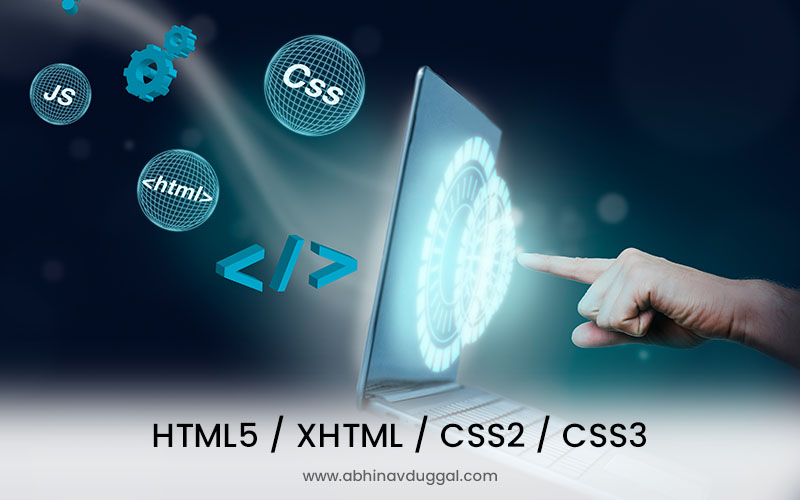HTML5 / XHTML / CSS2 / CSS3

HTML5, XHTML, CSS2, and CSS3 are the building blocks of modern websites and web applications. These technologies work together to create structure, style, and functionality for websites. Businesses, designers, and developers all over the world, including in growing IT hubs, are using these technologies to create user-friendly, responsive, and professional websites. Understanding these technologies is important for web development because they make websites attractive, fast, and compatible with different devices and browsers.
What is HTML5
HTML5 is the latest version of HyperText Markup Language. It is used to create the basic structure of a website. HTML5 introduced many new features that were not available in older versions.
Key Features of HTML5
Better support for multimedia like audio and video
New semantic elements such as
<header>,<footer>, and<section>Local storage and offline support
Improved forms with new input types
Cross-platform support for mobile and web applications
Benefits of HTML5
HTML5 makes websites faster and easier to build. It reduces the need for third-party plugins like Flash and provides a clean structure for modern web applications. It is also SEO-friendly, which helps websites rank better in search engines.
What is XHTML
XHTML stands for Extensible HyperText Markup Language. It is a combination of HTML and XML. XHTML follows stricter rules compared to HTML. Developers use XHTML to write clean, consistent, and error-free code.
Key Features of XHTML
Follows XML rules strictly
Ensures clean and well-formed code
Compatible with different browsers
Provides better error handling
Benefits of XHTML
XHTML helps in creating websites that are more reliable and easier to maintain. It enforces strict coding standards, which reduces the chances of errors. Many companies and developers prefer XHTML for projects that require consistent and high-quality code.
What is CSS2
CSS2 stands for Cascading Style Sheets level 2. CSS2 was introduced to improve the design and layout of websites. It separated content from design, allowing developers to create more flexible and attractive websites.
Key Features of CSS2
Support for positioning elements (absolute, relative, fixed)
Better text and font styling
Print-friendly style sheets
Media types for different devices
Benefits of CSS2
CSS2 gave developers more control over website layouts. It made websites more consistent and easier to design. CSS2 also introduced better control for printing web pages and creating different designs for screens and devices.
What is CSS3
CSS3 is the most advanced version of Cascading Style Sheets. It introduced many modern design features and capabilities that were not possible in earlier versions. CSS3 works closely with HTML5 to create interactive and attractive websites.
Key Features of CSS3
Rounded corners, shadows, and gradients without images
Animations and transitions for interactive design
Flexbox and grid for advanced layouts
Media queries for responsive web design
Better font styling with @font-face support
Benefits of CSS3
CSS3 allows developers to create visually stunning websites without heavy images or scripts. It improves website speed, reduces load time, and provides a better user experience. CSS3 is essential for responsive design, making websites compatible with mobiles, tablets, and desktops.
Importance of HTML5 / XHTML / CSS2 / CSS3 in Web Development
These technologies are the foundation of web development. They ensure that websites are:
Structured properly with HTML5 or XHTML
Styled beautifully with CSS2 or CSS3
Responsive and mobile-friendly
Compatible across different browsers
SEO-optimized for better visibility
Comparison Between HTML5 and XHTML
HTML5 is flexible, while XHTML follows strict rules
HTML5 supports multimedia elements directly, XHTML does not
XHTML requires clean coding, while HTML5 allows more freedom
Both are used depending on the project requirement
Comparison Between CSS2 and CSS3
CSS2 focuses on basic styling, CSS3 introduces advanced effects
CSS3 supports animations and responsive design, CSS2 does not
CSS3 provides better layout control with grid and flexbox
CSS3 is faster and reduces the need for external images
How HTML5, XHTML, CSS2, and CSS3 Work Together
These technologies work as a team to build modern websites.
HTML5 or XHTML provides structure
CSS2 or CSS3 provides design and style
Together they create responsive, interactive, and visually appealing websites
Advantages of Using HTML5 / XHTML / CSS2 / CSS3
Easy to maintain and update websites
Lightweight and fast loading speed
Improved user experience with modern features
Cost-effective development with open standards
Global support from developers and communities
Applications of HTML5, XHTML, CSS2, and CSS3
These technologies are used in many areas of web development.
Web Design
Creating responsive and attractive website layouts.
Mobile Applications
Building mobile-friendly designs with HTML5 and CSS3.
E-commerce Websites
Creating user-friendly online stores that are secure and easy to navigate.
Content Management Systems
Designing and styling websites built with WordPress, Joomla, or Drupal.
Online Marketing
Designing landing pages, email templates, and promotional websites.
Future of HTML5 / XHTML / CSS2 / CSS3
The demand for these technologies will continue to grow as businesses move online. HTML5 and CSS3 will remain the core of web development, while XHTML and CSS2 still play a role in projects that require strict coding and compatibility. As new frameworks and tools are built on these standards, developers will continue to use them for creating innovative digital solutions.
Best Practices for Using HTML5 / XHTML / CSS2 / CSS3
Write clean and well-structured code
Use semantic elements in HTML5
Optimize CSS to reduce page load time
Use media queries for responsive design
Validate XHTML code to ensure standards compliance
Keep designs simple and user-focused
Conclusion
HTML5, XHTML, CSS2, and CSS3 are the backbone of web development. They provide structure, design, flexibility, and modern features to websites. Businesses and developers rely on these technologies to create responsive, attractive, and fast websites. Whether it is a simple website or a complex web application, these technologies play a key role in delivering quality digital solutions. By using them properly, developers can create websites that are not only functional but also user-friendly and SEO-optimized.
Why Customers Loves Us?

15+ Years Of Experience In Digital Industry
With over a decade of hands-on experience, we’ve helped businesses across industries thrive in the digital space. Our expertise ensures strategic, results-driven solutions tailored to your unique goals.

Guaranteed Results

Skilled Professional

Excellent Customer Support

Powerful Tools

Confidential Agreement









